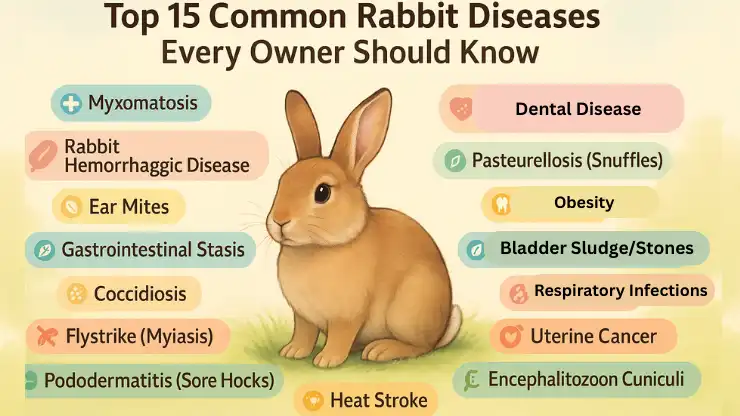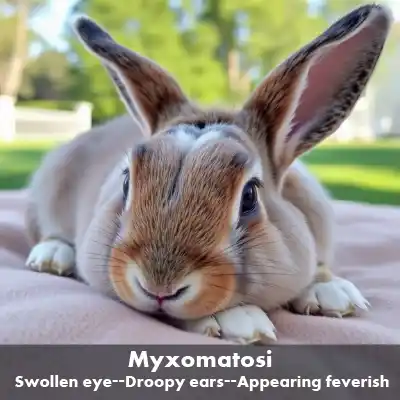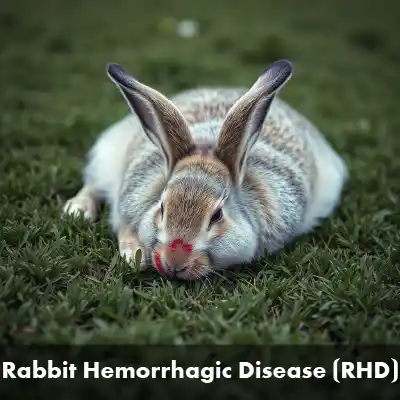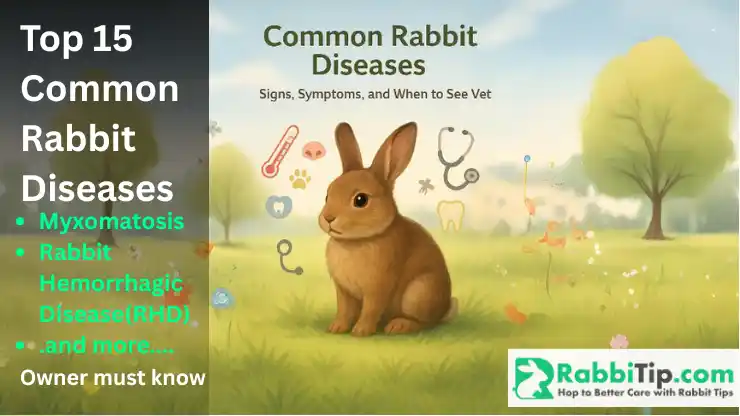Introduction
Do you own a pet rabbit? If you do, knowing about common rabbit diseases could save your furry friend’s life!
Rabbits can get sick quickly, and some problems like rabbit hemorrhagic disease can be very serious. Other issues like skin problems or kidney disease might not be easy to spot right away.
The good news is that you can help your bunny stay healthy by knowing what to look for. Quick action and vet care are key when your rabbit gets sick!
Key Takeaways
- Act fast when your bunny looks sick – rabbits can get very sick very quickly.
- Check your rabbit every day – look at their eyes, nose, poop, and how they act.
- Feed lots of hay – hay should be most of what they eat to keep them healthy.
- Get your rabbit shots to stop the worst sicknesses like RHD.
- Rush to the vet if your bunny can’t poop, can’t breathe well, has fits, or won’t move.
- Small changes can mean big trouble – a quiet bunny or one who won’t eat needs help.
- Keep cages clean and not too hot or cold to stop many health issues.
- Fix your rabbit (spay/neuter) to stop some types of cancer.
- Know who to call if your bunny gets sick at night or on weekends.
- Watch their weight and teeth – fat bunnies and bad teeth can cause many problems.
Comparison Table of Common Rabbit Diseases
| Disease Name | Risk Level | Common Signs | Vet Needed? |
|---|---|---|---|
| Myxomatosis | High | Swelling, fever, low energy | Yes |
| Rabbit Hemorrhagic Disease(RHD) | High | Bleeding, sudden death | Yes |
| Pasteurellosis (Snuffles) | Medium | Sneezing, runny nose | Yes |
| Ear Mites | Medium | Head shaking, crusty ears | Yes |
| Dental Disease | High | Drooling, not eating | Yes |
| Gastrointestinal Stasis | High | No poop, big belly | Yes |
| Coccidiosis | Medium | Runny poop, weight loss | Yes |
| Flystrike | High | Maggots, bad smell | Yes |
| Uterine Cancer | High | Blood in pee, lumps | Yes |
| Sore Hocks | Medium | Sore feet, limping | Sometimes |
| Encephalitozoon Cuniculi (E. Cuniculi) | Medium | Head tilt, seizures | Yes |
| Respiratory Infections | Medium | Hard breathing | Yes |
| Bladder Sludge/Stones | Medium | Strain when peeing | Yes |
| Obesity | Medium | Too heavy, not active | Sometimes |
| Heat Stroke | High | Panting, weakness | Yes |
The 15 Rabbit Diseases Explained
Knowing about common rabbit diseases can save your pet’s life! When rabbits get sick, they often hide it until they are very ill.

This guide will help you spot health problems early and know when to get help.
1. Myxomatosis
This deadly virus spreads through mosquito and flea bites. It causes puffy eyes, face swelling, and fever. There is no cure once symptoms start, so vaccination is key. If you see signs, get to a vet the same day!

Signs to Watch For:
- Puffy eyes that may swell shut
- Lumps or swelling on ears, face, and body
- Fever and very low energy
- Stop eating and drinking
- Runny nose and eyes
What Steps to Take: Keep your sick rabbit away from other rabbits right away. Put them in a clean, quiet, warm space. Offer water with a syringe if they won’t drink.
Home Remedy Options: No home remedy will work. This disease needs a vet immediately.
When to See a Vet: As soon as you see any signs! Myxomatosis can kill rabbits very quickly, often within 48 hours. This is an emergency.
2. Rabbit Hemorrhagic Disease (RHD)
RHD is a fast-killing virus that can strike with few warning signs. Some rabbits just die suddenly. Others may show bleeding from the nose or mouth. This disease moves so fast that prevention through shots is your best defense.

Signs to Watch For:
- Sudden death (sometimes with no warning)
- Bleeding from nose or mouth
- Very high fever
- Not wanting to move
- Having trouble breathing
What Steps to Take: Call your vet right away. Keep other rabbits away from the sick one. Wear gloves if you must handle them.
Home Remedy Options: None. This is a very deadly virus with no home treatment.
When to See a Vet: Immediately. RHD can kill in just 6-12 hours after symptoms start. Vaccination is the best way to prevent this deadly disease.
3. Pasteurellosis (Snuffles)
Does your bunny have a runny nose or wet paws from wiping it? Snuffles is a common bacterial illness that causes sneezing and nasal discharge. It can spread to other rabbits, so keep sick bunnies apart from healthy ones.
Signs to Watch For:
- Sneezing and runny nose
- White, thick discharge from nose
- Wet front paws from wiping nose
- Watery eyes
- Head tilting or shaking
What Steps to Take: Clean their nose gently with a warm, wet cloth. Make sure their home is clean and not dusty.
Home Remedy Options: Keep the area warm and clean. Offer lots of fresh water and tasty greens to keep them eating.
When to See a Vet: Within 24 hours. Snuffles can get worse fast and may need antibiotics.
4. Ear Mites
When rabbits shake their heads often or scratch at their ears, they may have ear mites. These tiny bugs cause crusty, itchy ears. Most cases aren’t deadly but are very uncomfortable for your pet.
Signs to Watch For:
- Shaking head often
- Scratching at ears
- Brown, crusty stuff in ears
- Red, sore-looking ears
- Holding head at an odd angle
What Steps to Take: Don’t try to clean deep in the ears. You might push the mites deeper or hurt the ear.
Home Remedy Options: Wipe only the outer ear with a warm, damp cloth. Don’t use any oils or home treatments unless your vet says it’s OK.
When to See a Vet: Within a few days. Ear mites are very itchy and painful but not usually life-threatening.
5. Dental Disease
Rabbit teeth grow forever and need to be worn down by chewing hay. Bad teeth lead to drooling, not eating, and weight loss. Dental problems can be very painful and often lead to other health issues if not fixed.
Signs to Watch For:
- Drooling or wet chin
- Not eating hay or hard foods
- Weight loss
- Bumps on jaw
- Bad smell from mouth
What Steps to Take: Offer soft, easy-to-eat foods like leafy greens. Make sure they keep eating something.
Home Remedy Options: No home fixes for tooth problems. Keep offering hay even if they don’t eat it.
When to See a Vet: Within 24-48 hours. A rabbit that stops eating can die quickly from gut problems.
6. Gastrointestinal Stasis
This is a bunny emergency! When the gut stops moving, rabbits stop eating and pooping. They may sit hunched in pain. GI stasis can kill within a day if not treated, so quick action is vital.

Signs to Watch For:
- No poop or very small poops
- Big, hard belly
- Not eating or drinking
- Sitting hunched in a corner
- Grinding teeth (sign of pain)
What Steps to Take: Gently rub their belly in a clockwise direction. Offer wet leafy greens, herbs, or grass.
Home Remedy Options: Give small amounts of pineapple juice (not from concentrate) with a syringe. Keep them moving with gentle exercise.
When to See a Vet: Same day. This is very serious and can kill within 24 hours. GI stasis is one of the top killers of pet rabbits.
7. Coccidiosis
This gut parasite causes diarrhea and weight loss, even as the belly looks big. Young rabbits get sicker faster from it. Good cage cleaning helps prevent this problem from spreading.
Signs to Watch For:
- Runny or sticky poop
- Weight loss
- Big belly but skinny body
- Dull fur
- Low energy
What Steps to Take: Clean their cage very well. Change bedding daily. Wash your hands after handling.
Home Remedy Options: No home cures work. Keep giving fresh water and clean food while waiting for vet care.
When to See a Vet: Within 1-2 days. Young rabbits can get very sick very fast with this infection.
8. Flystrike (Myiasis)
This horrible condition happens when flies lay eggs on dirty rabbit fur, often around the bottom. Maggots hatch and eat into the skin. It’s extremely painful and needs emergency care to save your rabbit’s life.
Signs to Watch For:
- Flies around your rabbit
- Maggots on skin or fur
- Awful smell
- Wet fur around bottom
- Rabbit seems very sick or still
What Steps to Take: Pick off any visible maggots with tweezers. Clean dirty areas with warm water.
Home Remedy Options: After removing maggots, you can clean the area with diluted saline solution. Cover with a clean cloth.
When to See a Vet: Emergency – same day! Flystrike can kill within hours as maggots eat into the skin.
9. Uterine Cancer
Female rabbits who aren’t spayed have a high risk of uterine cancer as they age. Signs include blood in urine and lumps in the belly. Spaying young prevents this common killer completely.
Signs to Watch For:
- Blood in pee
- Lumps you can feel in belly
- Mood changes
- Less active
- Losing interest in food
What Steps to Take: Check if your female rabbit is spayed. If not, this is a common problem in unspayed females.
Home Remedy Options: None. Cancer needs vet care.
When to See a Vet: Within a week of noticing symptoms. This cancer grows slowly but needs to be treated.
10. Pododermatitis (Sore Hocks)
When rabbits get sore feet, they may limp or stop moving. This happens from wire floors, wet bedding, or being overweight. Proper flooring and bedding can prevent most cases of sore hocks.
Signs to Watch For:
- Bald spots on bottom of feet
- Red, sore-looking skin on feet
- Limping or not moving much
- Blood spots in cage
- Not wanting to be picked up
What Steps to Take: Check flooring in cage – should be soft, not wire. Add thick bedding or fleece.
Home Remedy Options: Clean sores gently with saline water. Add soft bedding and keep it clean and dry.
When to See a Vet: Within a week for mild cases. Same day if you see open wounds or if rabbit won’t stand.
11. Encephalitozoon Cuniculi
This parasite affects the brain and kidneys, causing head tilt, loss of balance, or even seizures. Vestibular disease is often a sign of this infection. Regular deworming may help prevent it.
Signs to Watch For:
- Head tilt to one side
- Walking in circles
- Loss of balance
- Rolling over
- Seizures or shaking
What Steps to Take: Keep rabbit in a small, padded space so they don’t hurt themselves if they roll.
Home Remedy Options: No home remedy. This infection affects the brain and needs medicine.
When to See a Vet: Within 24 hours. This parasite causes vestibular disease in rabbits affecting balance.
12. Respiratory Infections
When rabbits have trouble breathing, it’s always serious. Look for open-mouth breathing or blue-tinted lips. Rabbits are nose-breathers, so any breathing problem needs quick vet care.
Signs to Watch For:
- Hard or noisy breathing
- Open-mouth breathing
- Blue-tinted lips or gums
- Not moving much
- Not eating
What Steps to Take: Keep in warm, clean place with good air. No strong smells or dust.
Home Remedy Options: Run a humidifier nearby (not directly on rabbit) to help with breathing.
When to See a Vet: Same day. Breathing problems can get worse very quickly in rabbits.
13. Bladder Sludge/Stones
Thick, cloudy pee or straining to urinate points to bladder problems. This can lead to rabbit kidney disease if not treated. Water intake is key to preventing these painful conditions.
Signs to Watch For:
- Thick, cloudy pee
- Straining to pee
- Blood in pee
- Wet bottom
- Peeing outside the litter box
What Steps to Take: Offer lots of fresh water. Add a small dish along with a water bottle.
Home Remedy Options: Give more water and fresh leafy greens with high water content. This can help with rabbit kidney disease and rabbit renal disease too.
When to See a Vet: Within 2-3 days. If the rabbit can’t pee at all, go immediately.
14. Obesity
Fat rabbits face many health risks like heart disease, sore hocks, and difficulty grooming. Too many sugary treats (Strawberries, dates) and not enough exercise lead to weight gain. Diet control is much easier than weight loss.
Signs to Watch For:
- Can’t feel ribs easily
- Double chin or dewlap gets bigger
- Trouble cleaning back end
- Can’t hop properly
- No waist when looking from above
What Steps to Take: Cut back on treats and pellets. Offer unlimited hay and controlled portions of greens. Timothy hay has great fiber and reduces sugar level. This is the best Hay for Rabbits to Eat.
Home Remedy Options: More exercise time outside the cage. Feed more hay and less treats.
When to See a Vet: At next regular checkup unless there are other symptoms.
15. Heat Stroke
Rabbits can’t sweat and overheat easily in hot weather. Panting, red ears, and weakness are danger signs. Never leave rabbits in direct sun or hot cars, even briefly.
Signs to Watch For:
- Panting
- Red ears
- Lying stretched out
- Not moving when approached
- Drooling
What Steps to Take: Move to cool place right away. Wet ears gently with cool (not cold) water.
Home Remedy Options: Place cool, damp towel against body. Offer cool water to drink.
When to See a Vet: Emergency – same day! Heat stroke can kill within hours.
Tips for Rabbit Health Monitoring
Daily Check Routine
- Eyes: Should be bright and clear, not runny or cloudy
- Nose: Clean with no discharge
- Ears: Clean inside, no scratching or head shaking
- Fur: Soft and clean, no bare patches or flakes
- Bottom: Clean with no poop stuck to fur
Diet for Disease Prevention
- Fresh hay should make up 80% of what your rabbit eats every day
- Fresh water must always be available – check twice daily
- Green veggies help keep the gut moving and prevent GI stasis.
- Limit pellets and treats to prevent obesity
- Any food changes should happen slowly to avoid tummy upset
Vaccination Schedule
“Vaccination is the best protection against deadly diseases like rabbit hemorrhagic disease and myxomatosis.” – Rabbit Veterinary Association
- Most rabbits need vaccines once a year
- Young rabbits can start vaccines at 5 weeks old
- Ask your vet about which shots your rabbit needs in your area
- Keep a calendar of when shots are due
- Some areas need more frequent RHD shots if there’s an outbreak
Conclusion
Rabbits can get sick very fast, but now you know the warning signs to watch for! Most rabbit diseases can be treated if you catch them early enough.
Remember that a small change in how your rabbit acts could mean a big health problem. A bunny that’s not eating, has no poop, or seems “off” needs help right away.
Never wait to see if symptoms get better on their own. When in doubt, call the vet! Regular vet checks are also super important, even when your bunny seems fine.
Your rabbit depends on you to notice when something’s wrong. With the tips in this guide, you can help your fluffy friend live a long, healthy life!
FAQ Section
What disease is killing my rabbits?
The most deadly killers are Rabbit Hemorrhagic Disease (RHD) and Myxomatosis. Both can cause death within hours or days, often with little warning.
What is the most common cause of death in rabbits?
GI stasis (when the gut stops moving), untreated infections, and RHD are the top three causes of rabbit death. All three can happen very quickly.
Do bunnies get rabies?
It’s very rare for rabbits to get rabies. They are not typical carriers of this disease, so it’s not something most owners need to worry about.
Can rabbits get Lyme disease?
No, rabbits don’t get Lyme disease. However, they can carry ticks which might spread Lyme disease to people or other pets in your home.
Do rabbits carry diseases to dogs?
It’s rare, but some parasites like fleas or ticks could jump from rabbits to dogs. Most rabbit diseases only affect rabbits.
Can rabbits pass diseases to humans?
Very rarely. Some bacterial infections or parasites can pass to humans, but it’s not common. Washing hands after handling your rabbit helps stay safe.
Do bunny rabbits carry diseases?
Healthy rabbits are usually very safe pets. Sick rabbits might carry some infections that can spread, which is why vet care is so important.
Stay Informed – Join Our Rabbit Health Community!
Did you find this guide helpful? Keep your bunny healthy by joining our free RabbiTip newsletter! Get expert advice, disease alerts, and care tips delivered straight to your inbox.
Simply enter your email at RabbiTip.com to never miss important rabbit health updates. Your furry friend will thank you!
Share your rabbit health experiences in the comments below. Have you dealt with any of these conditions? What worked for you? Your story might help another rabbit owner spot problems early!
Together we can keep our bunnies hopping happily for years to come!

